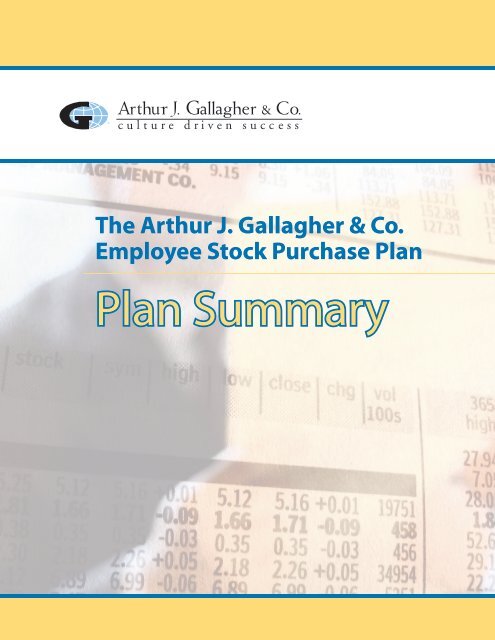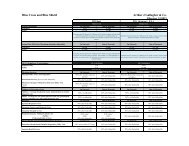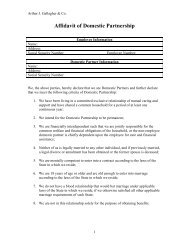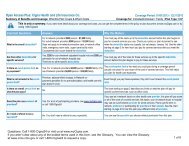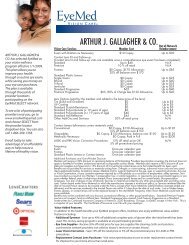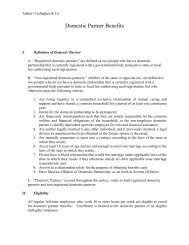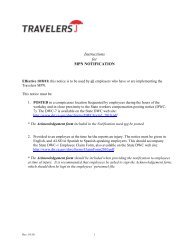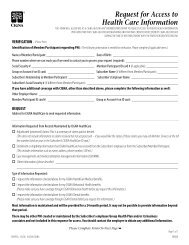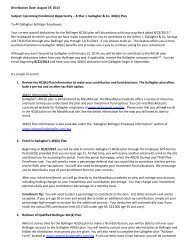Employee Stock Purchase Plan Brochure
Employee Stock Purchase Plan Brochure
Employee Stock Purchase Plan Brochure
You also want an ePaper? Increase the reach of your titles
YUMPU automatically turns print PDFs into web optimized ePapers that Google loves.
The Arthur J. Gallagher & Co.<br />
<strong>Employee</strong> <strong>Stock</strong> <strong>Purchase</strong> <strong>Plan</strong><br />
<strong>Plan</strong> Summary
Legal Notice<br />
Participation in the Arthur J. Gallagher & Co. <strong>Employee</strong> <strong>Stock</strong> <strong>Purchase</strong> <strong>Plan</strong> (the “<strong>Plan</strong>”) is entirely voluntary,<br />
and Arthur J. Gallagher & Co. (the “Company”) makes no recommendations to its employees with respect<br />
to the purchase of its stock and participation in the <strong>Plan</strong>. There is no guarantee under the <strong>Plan</strong> against loss<br />
because of market fluctuations. In seeking share ownership, you must also accept the risks.<br />
The <strong>Plan</strong> Summary does not include the complete <strong>Plan</strong> details as these are contained in the official <strong>Plan</strong><br />
documents, which legally govern the administration of the <strong>Plan</strong>. Every effort has been made to ensure the<br />
accuracy of the information contained in this <strong>Plan</strong> Summary. In the event there is a difference between<br />
what is written here and what is contained in the <strong>Plan</strong> document, the official <strong>Plan</strong> document will prevail.<br />
This <strong>Plan</strong> Summary is not an offer or contract of continued employment with Arthur J. Gallagher & Co.<br />
Arthur J. Gallagher & Co. expects to continue the <strong>Employee</strong> <strong>Stock</strong> <strong>Purchase</strong> <strong>Plan</strong>; however, the Company<br />
reserves the right to amend, change, modify, or terminate the <strong>Plan</strong> at any time and for any reason.<br />
This document has been written by Arthur J. Gallagher & Co. and is the sole responsibility of Arthur J.<br />
Gallagher & Co.<br />
Fidelity <strong>Stock</strong> <strong>Plan</strong> Services and Arthur J. Gallagher & Co. are not affiliated.
Find It Fast...<br />
> Introduction 3<br />
> Before Investing 4<br />
> Joining the ESPP 5<br />
> Making Contributions 6<br />
> Buying Shares 7<br />
> Selling Shares 8<br />
> Situations Affecting <strong>Plan</strong> Benefits 10<br />
> U.S. Federal Tax Consequences 11<br />
> Managing Your Account 13<br />
> Other Information 14<br />
> Glossary of Terms 15<br />
Introduction<br />
If you are looking for a way to invest in<br />
your future and contribute to Arthur J.<br />
Gallagher & Co.’s growth and success,<br />
you should consider the Arthur J.<br />
Gallagher & Co. <strong>Employee</strong> <strong>Stock</strong> <strong>Purchase</strong><br />
<strong>Plan</strong> (ESPP). This <strong>Plan</strong> Summary is<br />
designed to help you learn more about<br />
the ESPP so that you can decide if and<br />
how the <strong>Plan</strong> fits within your personal<br />
investment portfolio.<br />
The ESPP enables eligible employees to<br />
purchase common shares of Gallagher<br />
stock at a 5% discount from its Fair<br />
Market Value through convenient payroll<br />
deductions. By selecting a contribution<br />
amount, you can buy Gallagher stock<br />
more easily and less expensively than<br />
investors who are not employees of the<br />
Company. Another advantage is that<br />
you will not incur brokerage fees on the<br />
purchase.<br />
The Company issues the shares of<br />
Gallagher stock and transfers them to<br />
Fidelity <strong>Stock</strong> <strong>Plan</strong> Services, who holds<br />
the stock in participant accounts. You may<br />
start, stop, or change your participation in<br />
the program in accordance with the <strong>Plan</strong>’s<br />
provisions.<br />
When you own shares of Gallagher stock,<br />
you have a stake in the future of Arthur J.<br />
Gallagher & Co. and may participate in<br />
Gallagher’s decision-making through<br />
shareholder voting. Each share you hold<br />
entitles you to one vote.<br />
Participation in the ESPP is voluntary<br />
and both the opportunities and the risks<br />
should be considered carefully.<br />
3
Before Investing<br />
Arthur J. Gallagher & Co. common stock is traded on the New York <strong>Stock</strong> Exchange<br />
(NYSE) under the symbol AJG.<br />
The U.S. Securities and Exchange Commission (SEC) requires public companies like<br />
Arthur J. Gallagher & Co. to file reports that disclose financial and other information<br />
to the public. This provides a steady flow of timely and comprehensive information<br />
to help all investors, whether large institutions or private individuals, make sound<br />
investment decisions. These filings are available on the EDGAR section of the SEC’s<br />
website (www.sec.gov), or through the Investor Relations tab on the home page at<br />
www.ajg.com.<br />
Understand the Rewards and Risks<br />
of Being a <strong>Stock</strong>holder<br />
When you purchase Gallagher stock, you<br />
have the opportunity to participate in<br />
the profits you help generate. You have<br />
the opportunity to personally benefit<br />
from any growth in the Company’s<br />
stock price. In addition, the stock is<br />
purchased at a discount and you do not<br />
pay any commission, account fees or<br />
administration cost when buying shares<br />
of Company stock through the ESPP. In<br />
addition to these rewards, you should<br />
understand that purchasing individual<br />
shares of a company’s stock carries risks.<br />
<strong>Stock</strong> prices can fluctuate, and if the price<br />
of Gallagher stock declines, you could<br />
lose money that you have contributed to<br />
the ESPP.<br />
Insider Trading<br />
All participants in the ESPP are subject<br />
to Arthur J. Gallagher & Co. policies<br />
and federal and state laws restricting<br />
trading on material non-public or<br />
“insider” information. In addition, certain<br />
employees may require pre-clearance<br />
from the Company’s legal department<br />
prior to selling Gallagher stock purchased<br />
under the ESPP. If you are unsure about<br />
whether these special restrictions apply<br />
to you, please contact a Fidelity <strong>Stock</strong><br />
<strong>Plan</strong> Services Representative before<br />
conducting any transaction.<br />
Outside the United States, representatives<br />
are available at 800-544-0275 (toll-free)<br />
Monday through Friday from 8 a.m. to<br />
8 p.m., local time, excluding holidays of<br />
the New York <strong>Stock</strong> Exchange.<br />
Arthur J. Gallagher & Co.<br />
<strong>Employee</strong> <strong>Stock</strong> <strong>Purchase</strong> <strong>Plan</strong><br />
4
Joining the ESPP<br />
Who is eligible?<br />
You are eligible to participate in the ESPP if<br />
you are at least 18 years old and satisfy each of<br />
the following conditions:<br />
»»<br />
Have been continuously employed by<br />
the Company for at least three months.<br />
»»<br />
Customarily work more than 20<br />
hours per week (not applicable to UK<br />
employees).<br />
»»<br />
Customarily work more than five<br />
months in a calendar year.<br />
»»<br />
Do not own 5% or more of the total<br />
voting power or value of the Company,<br />
any parent or subsidiary of the<br />
Company.<br />
When can I enroll?<br />
Throughout the year, you will have four<br />
opportunities to enroll. If you do not<br />
enroll for the first offering period after you<br />
become eligible, you may enroll during any<br />
subsequent enrollment period. Enrollment<br />
periods will typically occur during the twoweek<br />
period immediately preceding the<br />
beginning of a calendar quarter (or the next<br />
business day if the NYSE is closed on any of<br />
those dates).<br />
Your payroll deductions will begin on the<br />
first pay date after the beginning of the<br />
offering period immediately following your<br />
enrollment.<br />
Enrollment Period<br />
Offering Period<br />
Begins<br />
Payroll Deductions<br />
Share <strong>Purchase</strong><br />
Period<br />
(first week of<br />
listed month)<br />
December 16–31 January January 1 – March 31 April<br />
March 16–31 April April 1 – June 30 July<br />
June 16–30 July July 1 – September 30 October<br />
September 16–30 October October 1 – December 31 January<br />
How can I enroll?<br />
You may access Fidelity’s website at<br />
www.netbenefits.fidelity.com and<br />
follow the instructions on your screen.<br />
If you prefer, you may contact a Fidelity<br />
<strong>Stock</strong> <strong>Plan</strong> Services Representative.<br />
In the United States, representatives<br />
are available at 800-544-9354 (toll free)<br />
between the hours of 5 p.m. Sunday and<br />
Midnight Friday, Eastern Time, excluding<br />
the holidays of the New York <strong>Stock</strong><br />
Exchange.<br />
Outside the United States,<br />
representatives are available at<br />
800-544-0275 (toll free) Monday through<br />
Friday from 8 a.m. to 8 p.m., local time,<br />
excluding holidays of the New York <strong>Stock</strong><br />
Exchange.<br />
If you wish to speak with a translator,<br />
please advise Fidelity <strong>Stock</strong> <strong>Plan</strong> Services<br />
at the time of your call.<br />
When enrolling online or by telephone,<br />
you will need to first certify your account.<br />
As part of this process you will provide<br />
your employee identification number<br />
and your username / Social Security<br />
Number. Participants outside the United<br />
States will need both their employee<br />
identification number and their<br />
Participant identification number, which<br />
is a unique identifier provided by Fidelity<br />
<strong>Stock</strong> <strong>Plan</strong> Services. When you first access<br />
your account after you have certified, you<br />
will be required to select a new password.<br />
You may easily change your password at<br />
any time. (See Managing Your Account<br />
section for detailed instructions on<br />
accessing your ESPP.)<br />
5<br />
Arthur J. Gallagher & Co.<br />
<strong>Employee</strong> <strong>Stock</strong> <strong>Purchase</strong> <strong>Plan</strong>
Making Contributions<br />
Arthur J. Gallagher & Co. makes it easy for you to participate in the ESPP through<br />
convenient and automatic payroll deductions. Your payroll contributions are made<br />
on an after-tax basis and will be held by the Company in a non-interest bearing <strong>Plan</strong><br />
account until the contribution period is complete. You can see the accumulated total<br />
of your deductions for any given purchase period on Fidelity’s website, Netbenefits.<br />
How much can I contribute?<br />
For each pay period, you may contribute<br />
a percentage between 1% and 15% of<br />
your eligible compensation to purchase<br />
Gallagher stock. Your payroll deduction<br />
election must be made in a whole<br />
percentage. The IRS limits the amount<br />
of stock you may purchase through the<br />
ESPP. You may purchase up to a maximum<br />
of $25,000 U.S. dollars worth of Gallagher<br />
stock per calendar year based on the<br />
grant Fair Market Value.<br />
When do my payroll contributions<br />
begin?<br />
Following your enrollment, your payroll<br />
deductions will begin with your first pay<br />
after the beginning of the offering period.<br />
For example, if you enroll in the ESPP by<br />
the June 30 enrollment deadline, your<br />
payroll deduction will begin on your<br />
July 15 paycheck.<br />
May I change my contribution<br />
amount?<br />
Once you have established your account<br />
and selected your payroll deduction, you<br />
can make changes as follows:<br />
»»<br />
During the enrollment period—There is<br />
no limit to the number of times you can<br />
make changes during the enrollment<br />
period. You may increase, decrease,<br />
or cancel your deductions. The last<br />
election that you make during the<br />
enrollment period will be processed as<br />
your final election and a confirmation of<br />
that election will be mailed to you after<br />
the enrollment period closes.<br />
»»<br />
During the offering period—You can<br />
elect to cancel your payroll deductions<br />
at any time prior to the last two weeks<br />
of the quarterly offering period. If you<br />
cancel, you can elect to either receive<br />
a refund of your payroll deductions<br />
deducted during the quarter that<br />
have not yet been used to purchase<br />
shares, or you can use those existing<br />
contributions to purchase shares<br />
through the <strong>Plan</strong> at the end of the<br />
quarterly offering period. Once you<br />
cancel your participation, you must wait<br />
for a future offering period to re-enroll.<br />
How do I change or cancel my<br />
contributions?<br />
To make changes you may:<br />
Access Fidelity’s website, Netbenefits, at<br />
www.netbenefits.fidelity.com.<br />
If you prefer, you may contact a Fidelity<br />
<strong>Stock</strong> <strong>Plan</strong> Services Representative.<br />
In the United States, representatives<br />
are available at 800-544-9354 (toll free)<br />
between the hours of 5 p.m. Sunday and<br />
Midnight Friday, Eastern Time, excluding<br />
the holidays of the New York <strong>Stock</strong><br />
Exchange.<br />
Outside the United States,<br />
representatives are available at<br />
800-544-0275 (toll free) Monday through<br />
Friday from 8 a.m. to 8 p.m., local time,<br />
excluding holidays of the New York <strong>Stock</strong><br />
Exchange.<br />
If you wish to speak with a translator,<br />
please advise Fidelity <strong>Stock</strong> <strong>Plan</strong> Services<br />
at the time of your call.<br />
Arthur J. Gallagher & Co.<br />
<strong>Employee</strong> <strong>Stock</strong> <strong>Purchase</strong> <strong>Plan</strong><br />
6
Buying Shares<br />
When you enroll, you decide how much you want to contribute and elect the<br />
percentage to be deducted from your paycheck. Your deduction will be made on<br />
an after-tax basis. Your contribution amount will accumulate during a three-month<br />
quarterly stock purchase period and will be used to buy shares of Arthur J. Gallagher &<br />
Co. common stock in your name at the end of the period. Unless you make a change,<br />
your payroll deductions will continue and the stock will be purchased on your behalf.<br />
You may not purchase more than $25,000 or 2000 shares of stock through the ESPP<br />
in any calendar year, based on the Fair Market Value of the stock on your enrollment<br />
effective date. If you reach this limit, you will be notified.<br />
Once the shares have been credited to your account, you will have the same rights and<br />
privileges afforded to all other Arthur J. Gallagher & Co. shareholders.<br />
When can I buy stock?<br />
Generally the shares are purchased on your behalf at the end of each quarterly stock<br />
purchase period listed below.<br />
If you enroll between:<br />
Your contribution will be deducted<br />
from your paycheck between:<br />
<strong>Stock</strong> will be purchased<br />
during the first week of:<br />
December 16–31 January 1 – March 31 April<br />
March 16–31 April 1 – June 30 July<br />
June 16–30 July 1 – September 30 October<br />
September 16–30 October 1 – December 31 January<br />
Who will purchase the stock?<br />
Fidelity <strong>Stock</strong> <strong>Plan</strong> Services is the provider<br />
of record-keeping and administrative<br />
services for our <strong>Employee</strong> <strong>Stock</strong> <strong>Purchase</strong><br />
<strong>Plan</strong> and purchases shares of Arthur J.<br />
Gallagher & Co. common stock on your<br />
behalf.<br />
How do I benefit from having<br />
Fidelity <strong>Stock</strong> <strong>Plan</strong> Services service<br />
my account?<br />
Fidelity <strong>Stock</strong> <strong>Plan</strong> Services makes it<br />
easy and convenient for you to manage<br />
your shares online via Netbenefits at<br />
www.netbenefits.fidelity.com or with<br />
the help of Fidelity <strong>Stock</strong> <strong>Plan</strong> Service<br />
Representatives, and provides you with<br />
annual tax forms detailing reportable tax<br />
information.<br />
What is the Fair Market Value?<br />
The Fair Market Value (FMV) is the price<br />
of a share of Gallagher stock at a certain<br />
period in time. The FMV of a share of<br />
Gallagher stock, for purposes of the<br />
ESPP, is the lesser of the closing price on<br />
the first day or last day of each offering<br />
period.<br />
How is the purchase price<br />
determined?<br />
For each quarterly plan period, the<br />
purchase price is calculated by taking the<br />
Fair Market Value and subtracting the 5%<br />
discount. For example, if the Fair Market<br />
Value is $22.50, the purchase price would<br />
be $21.38.<br />
7<br />
Continued on page 8<br />
Arthur J. Gallagher & Co.<br />
<strong>Employee</strong> <strong>Stock</strong> <strong>Purchase</strong> <strong>Plan</strong>
Buying Shares (continued)<br />
Will I receive dividends under the<br />
ESPP?<br />
Yes. Any dividends paid to you for shares<br />
of stock purchased under the ESPP are<br />
paid in cash. If you would like to have your<br />
dividends reinvested to purchase additional<br />
shares of Gallagher stock, simply log on to<br />
www.netbenefits.fidelity.com.<br />
You may also contact a Fidelity <strong>Stock</strong> <strong>Plan</strong><br />
Services Representative to help you.<br />
Are my Arthur J. Gallagher & Co.<br />
stock rights transferable?<br />
No. You may not transfer, pledge, or<br />
assign your rights acquired under the<br />
ESPP to anyone else, except in the event<br />
of your death. While you are living, your<br />
rights can only be exercised by you.<br />
Will I receive a stock certificate?<br />
No, you will not receive a stock certificate<br />
at the time of purchase. Instead, the<br />
stock will be deposited in your individual<br />
brokerage account maintained by Fidelity<br />
<strong>Stock</strong> <strong>Plan</strong> Services. In addition you will<br />
receive a quarterly statement of your<br />
account, which will tell you the number of<br />
shares of Gallagher stock in your account<br />
and the value as of a specific date.<br />
Selling Shares<br />
Arthur J. Gallagher & Co.<br />
<strong>Employee</strong> <strong>Stock</strong> <strong>Purchase</strong> <strong>Plan</strong><br />
Once your shares are purchased and<br />
allocated to your account, you can<br />
generally sell them at any time or<br />
continue to hold them in your account.<br />
This decision is up to you. However, there<br />
are different tax consequences when you<br />
dispose of your shares, depending on<br />
how long you have held them.<br />
Be aware that the price on the date you<br />
sell may differ from the price on the<br />
purchase date. In addition, you will incur<br />
fees in selling the shares acquired under<br />
the ESPP. This may result in you incurring a<br />
loss on the stock acquired under the ESPP.<br />
How do I sell my stock?<br />
You may sell your Gallagher stock<br />
by accessing your ESPP online via<br />
www.netbenefits.fidelity.com, or by<br />
calling a Fidelity <strong>Stock</strong> <strong>Plan</strong> Services<br />
Representative.<br />
»»<br />
In the United States, representatives<br />
are available at 800-544-9354 (toll free)<br />
between the hours of 5 p.m. Sunday<br />
and Midnight Friday, Eastern Time,<br />
excluding the holidays of the New York<br />
<strong>Stock</strong> Exchange.<br />
8<br />
»»<br />
Outside the United States,<br />
representatives are available at 800-<br />
544-0275 (toll free) Monday through<br />
Friday from 8 a.m. to 8 p.m., local time,<br />
excluding holidays of the New York<br />
<strong>Stock</strong> Exchange.<br />
Please keep in mind you will need your<br />
username and your password to access<br />
your ESPP shares after your account is<br />
activated.<br />
If I sell my stock, what are my tax<br />
implications?<br />
Gains or losses associated with the sale<br />
of ESPP shares can be taxed at ordinary<br />
income and/or capital gains rates,<br />
depending on whether the stock was sold<br />
during or after the stock holding period.<br />
Continued on page 9
Selling Shares (continued)<br />
What is the stock holding period<br />
for common stock purchased under<br />
the ESPP?<br />
The stock holding period for shares of<br />
Gallagher common stock purchased<br />
through the ESPP is two years from the<br />
first day of the offering period, or one<br />
year from the day you purchased the<br />
stock, whichever is longer.<br />
Because tax laws are complicated and<br />
subject to change, you should consult<br />
with a qualified tax advisor before<br />
selling your stock. You may also review<br />
the section called U.S. Federal Tax<br />
Consequences.<br />
How is my stock sold?<br />
Sale transactions are executed in a real<br />
time environment and are available in<br />
three types.<br />
The following types of orders are<br />
available when placing a sale transaction:<br />
»»<br />
Market Order—This order is processed<br />
at the next available sale price as soon<br />
as market conditions allow.<br />
»»<br />
Limit Order Day—This order allows<br />
you to specify a minimum price<br />
at which you want your sale to be<br />
processed. If during the trading day,<br />
the sale price equals or exceeds the<br />
minimum price you specified, your<br />
order will be executed the next<br />
available trade as market conditions<br />
allow. If it does not reach or exceed the<br />
price you indicate, your order will be<br />
canceled.<br />
»»<br />
Limit Order 30-Day—This order also<br />
allows you to indicate a minimum price<br />
at which you want your sale transaction<br />
to be placed. Your order instructions will<br />
be effective for a maximum of 30 days<br />
and will be executed when the stock<br />
price equals or exceeds the minimum<br />
price you specified as market conditions<br />
allow. If the stock price does not meet<br />
or exceed the specified price within<br />
the 30-day period, your order will be<br />
canceled.<br />
9<br />
To aid in your decision, you are able to<br />
view the cost at which your shares were<br />
purchased and the length of time the<br />
shares have been held. If you are not<br />
selling all of the Company’s shares in your<br />
account, your shares will be sold on a first<br />
in, first out basis (your oldest shares will<br />
be sold first) unless you request specific<br />
share lots. You will be responsible for all<br />
fees associated with sales orders.<br />
How will I receive my sale<br />
proceeds?<br />
Upon sale of ESPP shares, proceeds<br />
are automatically deposited into your<br />
account. You will need to establish bank<br />
wire/check instructions (redemption fees<br />
may apply), so you can easily access your<br />
ESPP proceeds once they are available.<br />
Please go to netbenefits.fidelity.com to<br />
set up your bank wire/check instructions<br />
and learn how to request funds.<br />
May I transfer my shares to a Broker<br />
or as a Gift?<br />
To transfer shares out of your<br />
Fidelity <strong>Stock</strong> <strong>Plan</strong> Services account,<br />
contact a Fidelity <strong>Stock</strong> <strong>Plan</strong> Services<br />
Representative. You will be responsible<br />
for any associated fees.<br />
What are the Commissions and<br />
Fees?<br />
There are no fees charged to you for<br />
purchases when your payroll deductions<br />
are used to purchase shares. You are<br />
responsible for fees relating to any sale<br />
of Company stock, transfers to another<br />
account, wire transfer fees and duplicate<br />
account statements. Please note that all<br />
fees are subject to change.<br />
All fees are shown in U.S.<br />
dollars.<br />
A. Transaction fee—You will<br />
be charged for online sale<br />
transactions of Gallagher<br />
stock at a rate of $25 for the<br />
first 1000 shares and $0.02 per<br />
share after that.<br />
B. Sales fee—You will be charged<br />
the transaction fee in (A)<br />
above, plus a $3 handling<br />
fee. You will be subject to the<br />
standard SEC charges for sale<br />
of stock, as in effect at the<br />
time of your transaction.<br />
C. Foreign currency check fee—<br />
There is a fee of $5 for a check<br />
in a non-U.S. currency.<br />
D. There is a $7.95 fee to reinvest<br />
your ESPP dividend in the<br />
purchase of more Gallagher<br />
<strong>Stock</strong> each quarter.<br />
E. Wire transfer fee—The fee for<br />
a wire transfer is $15.<br />
F. Broker transfer fee—There is<br />
no fee for transfer to another<br />
domestic broker provided this<br />
is done via DTC (direct broker<br />
to broker).<br />
Arthur J. Gallagher & Co.<br />
<strong>Employee</strong> <strong>Stock</strong> <strong>Purchase</strong> <strong>Plan</strong>
Situations Affecting <strong>Plan</strong> Benefits<br />
If you leave the Company, your account<br />
will be available to you as long as you<br />
have shares in your account.<br />
If you wish to transfer shares,<br />
contact a Fidelity <strong>Stock</strong> <strong>Plan</strong> Services<br />
Representative. You will be responsible<br />
for transfer fees.<br />
When does my participation end?<br />
If you cease to be an eligible employee<br />
for any reason (e.g., termination of<br />
employment, change in status or death),<br />
your contributions to the ESPP will<br />
automatically end. All amounts deducted<br />
from your compensation and not<br />
previously used to purchase shares under<br />
the ESPP will be returned to you.<br />
You may also voluntarily terminate<br />
your <strong>Plan</strong> participation. If you elect to<br />
terminate from the ESPP, your payroll<br />
contributions will automatically cease.<br />
To resume participation in the ESPP, you<br />
will need to re-enroll during a future<br />
purchase period.<br />
In the event of your death while an active<br />
participant, your contributions that<br />
were not used to purchase shares will be<br />
refunded to your beneficiary or estate as<br />
soon as administratively possible.<br />
Arthur J. Gallagher & Co.<br />
<strong>Employee</strong> <strong>Stock</strong> <strong>Purchase</strong> <strong>Plan</strong><br />
10
U.S. Federal Tax Consequences<br />
The discounted purchase feature of your<br />
ESPP has been designed to comply with<br />
Section 423 of the Internal Revenue Code<br />
of 1986, as amended. You pay federal<br />
income taxes on the purchase of your<br />
shares only when you dispose of them—<br />
that is, when you sell them, give them as<br />
a gift or transfer them to another person<br />
for any reason—or upon your death if<br />
you still hold the shares.<br />
In general, you will be taxed on all or a<br />
portion of the purchase price discount<br />
amount and any capital gain or loss,<br />
depending on the difference between<br />
the value of the stock at the time of sale<br />
and at the time of purchase.<br />
The summary below outlines the tax laws<br />
that were in effect at the time this <strong>Plan</strong><br />
Summary was published. We recommend<br />
that you contact a tax advisor for specific<br />
questions regarding your individual<br />
situation, or if you are a non-U.S. citizen or<br />
resident. Tax consequences vary in other<br />
countries.<br />
Fidelity <strong>Stock</strong> <strong>Plan</strong> Services and<br />
Arthur J. Gallagher & Co. cannot make<br />
recommendations regarding your specific<br />
tax consequences.<br />
Qualifying Disposition<br />
If you dispose of your stock after the<br />
end of the stock holding period, you<br />
will recognize ordinary income for tax<br />
purposes equal to the lesser of:<br />
»»<br />
A percentage of the Fair Market Value of<br />
the stock at the beginning of the ESPP<br />
offering period equal to the discount<br />
rate applied at the time of purchase; or<br />
»»<br />
The amount, if any, by which your<br />
selling price exceeds the price at which<br />
you bought the shares (see F in table on<br />
following page).<br />
Any gain over and above ordinary income<br />
realized upon the sale of stock after the<br />
preferential tax treatment holding period<br />
is treated as long-term capital gain (see<br />
G in the table on the following page). If<br />
the stock is sold and the sale price is less<br />
than your discounted purchase price,<br />
there is no ordinary income, and you<br />
will have a long-term capital loss for the<br />
difference between the sale price and the<br />
discounted purchase price (see G in table<br />
on following page).<br />
Disqualifying Disposition<br />
If you dispose of your stock before the<br />
end of the stock holding period, your<br />
transaction is known as a “disqualifying<br />
disposition.” This means that you will<br />
recognize ordinary income for tax<br />
purposes equal to the difference between<br />
the market value of the stock at the<br />
time of purchase and your discounted<br />
purchase price, regardless of the stock’s<br />
value at the time of sale (see H in table on<br />
following page).<br />
Any gain above that difference will be<br />
taxable as capital gains. These capital<br />
gains will be short-term or long-term,<br />
depending on how long the stock has<br />
been held. However, please note that<br />
short-term capital gains are currently<br />
taxed at the same rates as ordinary<br />
income. Any loss, after calculating<br />
the ordinary taxable income, will be<br />
treated as a capital loss (See I in table on<br />
following page).<br />
Tax Examples<br />
The tables on the following page show<br />
how variables, such as stock price and the<br />
length of time you hold your stock, could<br />
affect your tax liability.<br />
These tables are provided as examples<br />
only. The exact amount you will pay as<br />
ordinary income and capital gains will<br />
depend on the law in effect at the time of<br />
sale and on your own personal situation.<br />
For you specific tax situation, please<br />
consult with your tax advisor.<br />
11<br />
Continued on page 12<br />
Arthur J. Gallagher & Co.<br />
<strong>Employee</strong> <strong>Stock</strong> <strong>Purchase</strong> <strong>Plan</strong>
Tax Example Tables<br />
Assumptions<br />
A. Fair market value on first day of<br />
offering period.<br />
B. Fair market value on the last day<br />
of offering period.<br />
C. Discounted purchase price<br />
(95% of the lesser fair market<br />
value – A or B).<br />
Example<br />
1<br />
Example<br />
2<br />
Example<br />
3<br />
Example<br />
4<br />
Example<br />
5<br />
$10 $10 $10 $10 $10<br />
$20 $20 $20 $20 $20<br />
$9.50 $9.50 $9.50 $9.50 $9.50<br />
D. Sale price. $30 $20 $17 $9 $7<br />
E. Actual gain (loss) (D minus C). $20.50 $10.50 $7.50 ($.50) ($2.50)<br />
Qualifying Disposition<br />
F. Ordinary income<br />
Lesser of: (1) 5% of fair market<br />
value at beginning of offering A,<br />
or (2) actual gain (E)<br />
Example<br />
1<br />
$.50<br />
(1)<br />
Example<br />
2<br />
$.50<br />
(1)<br />
Example<br />
3<br />
$.50<br />
(1)<br />
Example<br />
4<br />
$0<br />
(2)<br />
Example<br />
5<br />
G. Capital gain (loss) (E minus F). $20 $10 $7 ($.50) ($2.50)<br />
$0<br />
(2)<br />
Disqualifying Disposition<br />
Example<br />
1<br />
Example<br />
2<br />
Example<br />
3<br />
Example<br />
4<br />
Example<br />
5<br />
H. Ordinary income (B minus C). $10.50 $10.50 $10.50 $10.50 $10.50<br />
I. Capital gain (loss) (E minus H). $10 $0 ($3) ($11) ($13.00)<br />
Arthur J. Gallagher & Co.<br />
<strong>Employee</strong> <strong>Stock</strong> <strong>Purchase</strong> <strong>Plan</strong><br />
* Calculations assume a 5% discount at the time of purchase. The discount rate factor in C and<br />
F above should reflect the discount rate in effect at the time of purchase to calculate illustrative<br />
examples for shares purchased before January 1, 2009.<br />
12
Managing Your Account<br />
When you are newly eligible to enroll in the ESPP, you will receive notification via U.S.<br />
mail or email including instructions on how to get started. For participants in the U.S.,<br />
you will open a Fidelity Brokerage Account to manage your ESPP. For particiapnts<br />
outside the U.S., an account will be established for you and you will be sent information<br />
on how to activate and access your ESPP via Fidelity <strong>Stock</strong> <strong>Plan</strong> Services, including a<br />
unique identifier called a “Participant Identification Number.” Once you have activated/<br />
certified your account, you can access your account balance, specific <strong>Plan</strong> information,<br />
current share price, and perform sale transactions virtually 24 hours a day, 7 days a<br />
week through Fidelity’s website, Netbenefits, at www.netbenefits.fidelity.com or by<br />
contacting a Fidelity <strong>Stock</strong> <strong>Plan</strong> Services Representative.<br />
U.S. Participants<br />
»»<br />
Once you have activated your<br />
Fidelity Account®, log on to<br />
www.netbenefits.fidelity.com. You<br />
will see two types of links (or more if you<br />
have other accounts with Fidelity) – one<br />
for your ESPP and one for your Fidelity<br />
Account.<br />
»»<br />
Your ESPP—Your ESPP link reflects the<br />
payroll contributions deducted from<br />
your paycheck for the quarter. Note: if<br />
you are currently contributing, you will<br />
see this dollar balance increase each<br />
pay period throughout the offering<br />
period until the ESPP purchase occurs.<br />
When the stock purchase is made at the<br />
end of the quarter, the accumulated<br />
cash will be used to purchase shares<br />
in your Fidelity account and the value<br />
of your ESPP will be reduced to $0.<br />
Contributions will start accumulating in<br />
your ESPP again for the next quarter if<br />
you continue to contribute to the <strong>Plan</strong>.<br />
»»<br />
Your Fidelity Account—Your Fidelity<br />
Account (an individual brokerage<br />
account) holds your stock after each<br />
quarterly purchase. This is where<br />
you see the value of your stock and<br />
can initiate any transfer or sales<br />
transactions.<br />
»»<br />
Dividends—Your stock in the ESPP<br />
earns quarterly dividend payments.<br />
Your dividends will be deposited in<br />
your Fidelity Account as cash unless<br />
you contact Fidelity Investments to<br />
designate that you want to have your<br />
dividends reinvested in the purchase of<br />
additional Gallagher stock. To make this<br />
election online via NetBenefits, follow<br />
the steps below. (If you prefer, you<br />
may also contact a Fidelity <strong>Stock</strong> <strong>Plan</strong><br />
Services Representative.)<br />
1. Log on to www.netbenefits.fidelity.com<br />
2. Choose Individual Brokerage Account.<br />
3. Under “Act” in left-hand tool bar,<br />
choose “Update Accounts/Features.”<br />
4. Under “Account Features,” choose<br />
“Dividends and Capital Gains.”<br />
Dividends are paid on stock of which<br />
you are the recordholder as of the last<br />
day of the calendar quarter. For example,<br />
stock purchased for the quarter ending<br />
December 31 of a given year will not be<br />
eligible for dividends, if declared, that are<br />
paid the next year in January, but will be<br />
eligible for the March dividend payment,<br />
if declared.<br />
To access your account online, log on to<br />
www.netbenefits.fidelity.com.<br />
If you have questions or would like to<br />
speak to a Fidelity <strong>Stock</strong> <strong>Plan</strong> Services<br />
Representative, call 800-544-9354.<br />
Continued on page 14<br />
13<br />
Arthur J. Gallagher & Co.<br />
<strong>Employee</strong> <strong>Stock</strong> <strong>Purchase</strong> <strong>Plan</strong>
Managing Your Account (continued)<br />
International Participants<br />
»»<br />
The Participant Trust—Once<br />
you have certified the Participant<br />
Trust, log on to NetBenefits at<br />
www.netbenefits.fidelity.com to access<br />
your ESPP information. (You will<br />
need your Participant Number, which<br />
you received via email from Fidelity<br />
<strong>Stock</strong> <strong>Plan</strong> Services at the time you<br />
became eligible for the ESPP. Also, if<br />
this is the first time you are accessing<br />
the Participant Trust, please see the<br />
attached activation instructions.)<br />
»»<br />
Your ESPP—Your ESPP link reflects the<br />
payroll contributions deducted from<br />
your paycheck for the quarter, Note: if<br />
you are currently contributing, you will<br />
see this dollar balance increase each<br />
pay period throughout the offering<br />
period until the ESPP purchase occurs.<br />
When the stock purchase is made at the<br />
end of the quarter, the accumulated<br />
cash will be used to purchase shares<br />
in your Fidelity account and the value<br />
of your ESPP will be reduced to $0.<br />
Contributions will start accumulating in<br />
your ESPP again for the next quarter if<br />
you continue to contribute to the <strong>Plan</strong>.<br />
»»<br />
Dividends—Your stock in the ESPP<br />
earns quarterly dividend payments.<br />
Your dividends will be deposited in the<br />
Participant Trust as cash.<br />
Dividends are paid on stock of which<br />
are the recordholder as of the last day<br />
of the calendar quarter. For example,<br />
stock purchased for the quarter ending<br />
December 31 of a given year will not be<br />
eligible for dividends, if declared, that<br />
are paid the next year in January, but<br />
will be eligible for the March dividend<br />
payment, if declared.<br />
To access your account online, log on to<br />
www.netbenefits.fidelity.com.<br />
If you have questions or would like to<br />
speak to a Fidelity <strong>Stock</strong> <strong>Plan</strong> Services<br />
Representative, call 800-544-0275.<br />
Arthur J. Gallagher & Co.<br />
<strong>Employee</strong> <strong>Stock</strong> <strong>Purchase</strong> <strong>Plan</strong><br />
14
Other Information<br />
Be sure to keep all statements in a safe place. You will need the information to<br />
calculate your gain or loss should you sell your shares.<br />
Account Statements<br />
Fidelity <strong>Stock</strong> <strong>Plan</strong> Services will send you<br />
statements for the months in which you<br />
make purchases or have other activity in<br />
your account. If there is no activity, you<br />
will receive statements quarterly, and one<br />
annual statement.<br />
Tax Statements<br />
If you sell your shares, you will receive<br />
a Tax Reporting Statement (1099-B)<br />
each January. This statement contains<br />
important information about your gross<br />
proceeds. You will also receive a 1099-DIV<br />
for any dividends paid to your account.<br />
How To Read a <strong>Stock</strong> Quote<br />
It’s easy for you to follow the price of your<br />
company’s stock since major newspapers<br />
carry stock market information in their<br />
business sections. <strong>Stock</strong>s are listed<br />
alphabetically on a market. Arthur J.<br />
Gallagher & Co. stock trades on the NYSE.<br />
The stock ticker symbol is AJG. The chart<br />
below shows how to interpret the stock<br />
listings on the NYSE.<br />
52 Weeks<br />
Hi Lo <strong>Stock</strong> Sym Div Yld% PE<br />
Vol<br />
100s<br />
Hi Lo Close Chg<br />
13 7/8 8 XYZ Co. XYZ 40 3.1 6 1155 13 5/8 12 3/4 12 7/8 –1/2<br />
52-Week High/Low (Hi/Lo)<br />
<strong>Stock</strong><br />
Symbol (Sym)<br />
Dividend (Div)<br />
Yield % (Yld %)<br />
Price/ Earnings Ratio (PE)<br />
Volume 100s (Vol or Sales)<br />
High/Low (Hi/Lo)<br />
Close<br />
Net Change (Chg)<br />
The highest and the lowest prices, in U.S. dollars, at which this stock<br />
sold during the past 52 weeks.<br />
The abbreviated company name, in alphabetical order.<br />
The abbreviation assigned to your company by the market on which it<br />
is listed.<br />
The annual dividend per share of stock.<br />
The current annual dividend expressed as a percentage of the closing<br />
price.<br />
The closing price divided by annual earnings (profit) per share.<br />
The number of shares sold the previous day in 100s. (For this example,<br />
115,500 shares were sold the previous day.)<br />
The highest and lowest prices for the previous day. (Compare with<br />
52-Week High/Low)<br />
The last price that the stock was bought and sold at in the previous<br />
day’s trading.<br />
The difference between the closing price on the previous day and the<br />
day before in terms of positive (+) or negative (–) movement.<br />
Arthur J. Gallagher & Co.<br />
<strong>Employee</strong> <strong>Stock</strong> <strong>Purchase</strong> <strong>Plan</strong><br />
15
Glossary of Terms<br />
Contribution<br />
The amount you choose to deduct from your<br />
paycheck to purchase your plan shares.<br />
Deduction period<br />
The quarterly time period in which your<br />
payroll deductions are accumulated<br />
before the next plan purchase takes place.<br />
Disqualifying disposition<br />
If you dispose of your stock during the<br />
required holding period, your transaction is<br />
known as a disqualifying disposition.<br />
Dividend<br />
Distributions (either cash or stock), which<br />
may be paid to shareholders.<br />
Dividend reinvestment<br />
When cash dividends are used to<br />
purchase additional shares of stock.<br />
Eligible employee<br />
An employee who is eligible to<br />
participate in this plan. Gallagher<br />
determines which employees are eligible.<br />
ESPP Link<br />
Reflects the payroll contributions deducted<br />
from your paycheck each quarter. Will be<br />
reduced to $0 when the stock purchase is<br />
made at the end of the quarter.<br />
Fidelity Account<br />
A Fidelity Account ® is an individual<br />
brokerage account which has been<br />
opened for you to manage your<br />
Gallagher equity program participation.<br />
Within your Fidelity Account is a “central”<br />
money market account. This account<br />
holds your liquid assets (cash) until you<br />
invest or withdraw them. Any proceeds<br />
from the sale of your Gallagher stock will<br />
be deposited into your Fidelity Account.<br />
Holding period<br />
Two years from the first day of the offering<br />
period or one year from the day the stock<br />
was purchased, whichever is longer.<br />
Interactive Voice Response (IVR) system<br />
Fidelity <strong>Stock</strong> <strong>Plan</strong> Services automated<br />
system, which allows you to obtain<br />
information about your account from a<br />
touch-tone telephone.<br />
Offering<br />
The period in which Gallagher allows you<br />
16<br />
to make purchases of shares of company<br />
stock for your plan.<br />
Participant Identification Number<br />
A unique identifier assigned to<br />
participants outside the U.S. You will need<br />
this participant number to access your<br />
ESPP at Fidelity <strong>Stock</strong> <strong>Plan</strong> Services. You<br />
will receive your participant ID when you<br />
are eligible to enroll in the ESPP, via email<br />
from Fidelity <strong>Stock</strong> <strong>Plan</strong> Services.<br />
Participant Trust<br />
The Participant Trust is a “Grantor<br />
Trust” under U.S. law, a form of legal<br />
arrangement in which Fidelity Personal<br />
Trust FSB holds property as a trustee on<br />
your behalf, as an individual participant<br />
in the company’s stock plan. This applies<br />
outside the U.S. only.<br />
Password<br />
A six-digit number needed to access the<br />
Fidelity IVR system or website. Your initial<br />
six-digit password is the last six digits<br />
of your Social Security number (within<br />
the U.S.) or your assigned employee<br />
identification number (outside the U.S.).<br />
Proxy statement<br />
An information form distributed to<br />
shareholders by the company or by<br />
an agent of the company allowing<br />
shareholders to vote on corporate matters.<br />
<strong>Purchase</strong><br />
Your payroll contributions are used to buy<br />
shares of Gallagher stock.<br />
Share of stock<br />
A unit of equity ownership in a company.<br />
The number of shares owned represents<br />
the size of your investment.<br />
Shareholder<br />
An individual who owns stock in a<br />
company.<br />
Username<br />
This is your unique login Identification to<br />
access your ESPP on the Fidelity website.<br />
You create your username the first time<br />
you register. If you already have existing<br />
fidelity accounts, then you will use the<br />
same username to access your ESPP.<br />
Arthur J. Gallagher & Co.<br />
<strong>Employee</strong> <strong>Stock</strong> <strong>Purchase</strong> <strong>Plan</strong>
Corporate Headquarters<br />
Arthur J. Gallagher & Co.<br />
The Gallagher Centre<br />
Two Pierce Place<br />
Itasca, IL 60143-3141<br />
Telephone: 630.773.3800<br />
www.ajg.com<br />
June 21, 2011<br />
P:\Graphics\Corporate\Finance\Emp <strong>Stock</strong> <strong>Purchase</strong> <strong>Plan</strong>\ESPP Summary.indd


